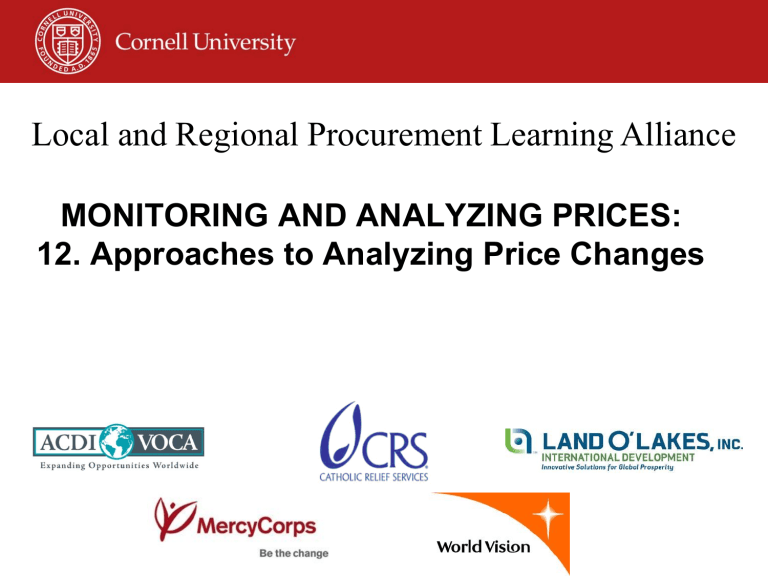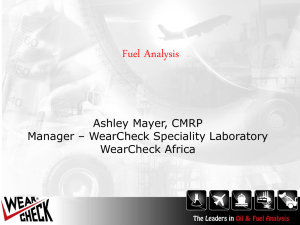LRP Price Analysis

Local and Regional Procurement Learning Alliance
MONITORING AND ANALYZING PRICES:
12. Approaches to Analyzing Price Changes
Overview of Monitoring and Analyzing Prices
Objectives of price monitoring and analysis:
• Identify which prices change and by how much
– Identify when to investigate further (using triggers)
• Identify factors that can cause price changes
– Data sources for these factors
– Analytical tools to evaluate the likelihood of each factor changing prices
2
Country offices are the first line of inquiry
• Country office market analysts understand local situation and can draw on multiple local sources (e.g., field staff, key informants, secondary data, news reports) to identify possible sources of price variability
3
Approach to identifying sources of price changes
• When a price change warrants further investigation, the market analyst will need to identify factors that may be causing prices to change
• Examine the following list of factors
– Other factors may also be relevant
– Note: prices can change due to a combination of factors
• Limit factor list to factors that have changed
• Use data and analytical tools to control for various factors that have changed
4
What might cause prices to change?
Frequent factors:
A. Inflation
B. Fuel prices
C. Seasonality
D. Demand shocks
E. Supply shocks
F. Trader collusion
G.Government / nongovernment interventions
H. Procurement or distribution
5
A. Inflation is an overall rise in the prices of goods and services in an economy, due to a decrease in the value of money.
• Nominal prices – the actual prices that you observe in the market
• Real prices – prices that have been adjusted for inflation
• The gap between the two series is inflation
B. Fuel: Fuel prices increase production costs and transportation costs; can also be a source of price variability, as seen below.
C. Seasonality: annual production or weather patterns. Causes prices to rise during the hungry season before the next main harvest. Commonly affects the rural poor and is associated with transitory food insecurity.
8
D. Demand shocks
• Demand shocks affect households’ abilities to access food, for example:
– Increased regional or global demand
– Access to certain markets eroded (e.g., due to infrastructural damage, insecurity, conflict)
– Increased local demand (e.g., due to localized crop failure, increased price of substitute product)
– Spikes in demand (e.g., due to festivals)
– Also, regular, seasonal increases in demand (e.g., own production doesn’t last until next harvest)
9
E. Supply shocks: Impacts on Supply Chains
Inputs (fuel, fertilizer, labor, weather)
Producers
Series of intermediary actors, including brokers, aggregators, wholesalers, processors, transporters
Retailers
Consumers
10
E. Supply shocks: Impacts on Supply Chains
• Supply shocks can disrupt the movement of food along any point of the supply chain, for example:
– increased price of inputs
– production failure or shortfall
– infrastructural damage along route
– transportation strike
– new regulations on processors
– conflict
– sudden introduction or lifting of trade barriers
11
F. Traders: Elements of Competitive Markets
• Competitive markets have the following elements:
– Fungibility and divisibility of commodities
– Firms are numerous
– Few or small barriers to firm entry or expansion
Or:
– Traders act as price takers
• When the above conditions are not met, traders may behave collusively
12
G. Governmental / Nongovernmental Policies
• Focus on changes to policies affecting behaviors of food market actors:
• Consumers
• Producers
• Traders and millers
• Are the various policies implemented?
• Are the policies enforced / enforceable?
• Local, national, or regional level - effects
• Consider both informal and formal policies
• Informal = outside of official governmental
• Formal policies may prompt emergence of parallel (or black) markets olicy
13
Categories of policies and impacts
FEWS Policy Impacts (2009, Lesson 3, p. 24 14
Categories of policies and impacts, cont.
FEWS Policy Impacts (2009, Lesson 3, p. 24) 15
Sources of policy risk for traders and food marketing
• Policy outcomes depend on number of factors aside from policy design:
• Implementation, institutional strength, enforcement
• Transparency and responsiveness of policymakers
• Stability / fickleness of policy regimes
• Traders face policy risk:
• Lack of transparency
• Lack of predictability
• Variable enforcement
16
H. Procurement or distribution
• Creating price risk for consumers, producers and traders is an often-cited concern for all food assistance programs.
• What is the size of the program relative to the local economy?
• What is the timing relative to seasonal price patterns?
• Large, poorly timed programs have a greater chance of impacting prices.
17
Often, there are multiple factors at work: Maize prices vs. import parity – Lilongwe, Malawi
• 2000-2001:
– Poor rainfall
– Government sold grain reserve, depressing prices far below import parity prices
– Due to low prices, farmers couldn’t afford inputs for next season
• 2001-2002
– Poor rainfall
– Farmers harvested green maize as coping strategy
– Government did not adequately restock reserve prior to 2001-2002 crisis
– Price spike
– Imports for commercial and humanitarian purposes
18
Source: http://www.imf.org/external/np/exr/facts/malawi.htm
Often, there are multiple factors at work:
Maize prices vs. import parity – Lilongwe, Malawi
700
600
500 c.i.f. Lilongwe from South Africa
Lilongwe retail
400
300
200
100
0
1996 1998 2000 2002 2004 2006 2008
Improving the Performance of Staple Markets to Exploit the Productive Potential of Smallholder Agriculture
T. S. Jayne, A. Chapoto, and B. Shiferaw
AGRA Conference on “Towards Priority Action for Market Development for African Farmers,” Nairobi, Kenya, May 13-15, 2009
Data Sources for Analyzing Factors
Factor
Inflation
Fuel prices
Seasonality
Demand Shocks
Supply Shocks
Policies
Trader Collusion
Procurement or distribution*
Data Sources for Analysis
Consumer Price Index from secondary data
Fuel Prices from secondary data
Seasonal calendar and historical prices
Media and key informants; Marketshed map
Media and key informants; Marketshed map
Media and key informants; Marketshed map
Key informants; Marketshed map
Historical prices; controlling other factors (more indepth work to be done by CU)
20
Approaches to Analyzing Factors
• Examine whether any factors have changed
• For each factor that has changed, use appropriate data and tools to determine whether the price changes are consistent or inconsistent with observed factor changes
• Can limit in-depth examination of factors based on whether prices changed across commodities and/or across markets
21
Approaches to Analyzing Factors
Prices change for a few commodities or a single commodity
Prices change in a single market or area
Marketshed Map
Key Informants
Historical Prices (if available)
Seasonal Calendar
Prices change for nearly all commodities
Marketshed Map
Key Informants
Historical Prices (if available)
Seasonal Calendar
Prices change in all domestic markets
Historical Prices
Seasonal Calendar
Key Informants
Historical Prices
Fuel and Inflation
Seasonal Calendar
Key Informants
22
• When to use:
– Inflation can cause prices to rise
– Check inflation when food prices across commodities and across markets change
• Generally, inflation occurs nationwide, and inflation causes prices to increase across all markets
– Rare for inflation to occur in just one region, unless there is a localized shock.
• In cases of changing prices in one market or region, determine whether such a shock has occurred
23
A. Inflation
• How to use:
– Consumer Price Index measures changes in prices for a basket of consumer goods and services over time. The base of the index is set equal to 100. The CPI is computed monthly or quarterly.
– Before using the CPI, check whether the index has been recalculated at any point for which you have price-data.
• If the CPI has been re-calculated, use price data that starts in the same period or after the new CPI
– To deflate nominal prices, divide food price series by the
CPI. If available, deflate historical data as well.
• When to use:
– Changes in fuel prices can change food prices
– Check fuel prices when food prices across commodities and across markets change
• Generally, fuel price changes lead to nation-wide food price changes
– Rare for fuel prices to change in just one region, unless there is a localized shock.
• Determine whether such a shock has occurred
25
B. Fuel prices
Market Maps in Real Time
– Graph fuel prices along with commodity prices
• If food and fuel prices follow the same pattern and fuel prices are changing, fuel prices may be a factor in price changes
• If food and fuel prices do not follow the same pattern, investigate other factors
• Plot the ratio of food to fuel price; as fuel prices change, how are food prices changing?
– Most countries’ central banks or finance ministries collect fuel prices for use in CPI computations
• Usually, fuel prices are reported for only one location (e.g., price at pump in capital)
26
• When to use:
– To identify seasonal price trends within years
– To identify price trends across markets over time
(where data are available)
• For example, if a single market has experienced a price change but other markets have not, check if that market has historically experienced similar changes (e.g., seasonal price reversals due to seasonal flow reversals)
– Use historical data as a benchmark for current price trends
27
• How to use:
– Where possible, use secondary data to graph historical prices by market.
– Compute month-to-month price change
– Compute seasonal price index
– Compute seasonal flow reversals, in cases where one area’s prices are more variable than other prices
– See Kenya example in powerpoint: “11 How are prices changing?”
28
• How to use:
– Compare historical prices changes with current price changes (for the same times of year)
– If current price changes are similar to historical changes, it is unlikely that procurement or distribution are strongly influencing current prices
– If historical prices are relatively stable, and current prices are not, further investigation into why current prices are fluctuating heavily will be important
29
D. Key informant interviews and news sources
• When to use:
– Government announces or enacts policy changes affecting food markets
– New or possible demand shocks
– New or possible supply shocks
– Possible trader collusion
• Read available media accounts prior to contacting key informants
30
D. Key informant interviews and news sources
• Who to ask:
– Ask informants knowledgeable about location(s) of price changes
• local level (distribution or procurement area)
• national, regional, or global level
• government / policy level
– Targeted discussions with field staff, traders, officials, market administrators, producers, or recipients
• recipients, traders can speak to demand shocks
• producers, traders can speak to supply shocks
D. Key informant interviews and news sources
• What to ask:
– Information on specific factors
– Duration of the change
– Future direction and severity of the change
– Likely geographic reach of change
– Impact of change on markets / businesses
32
• When to use:
– Use with historical (weekly or monthly) price data to establish normal seasonal price fluctuations
– Seasonal calendars are useful for understanding how prices may normally change during a year
– Seasonal calendars can be used to anticipate the direction of future prices changes
• If prices are not moving in directions consistent with seasonality, investigate further
• If prices are moving in directions consistent with seasonality, but are larger than changes in historical prices for the same seasons, investigate further 33
E. Seasonal Calendar (See Worksheet)
• How to use:
– See accompanying worksheet on list of guiding topics that may be important to include in a seasonal calendar (timing of weather, timing of key staple production, timing of lean season, regular shocks or ceremonies, etc.)
• Some topics may not be relevant
– Focus on creating calendars for procurement and distribution sites
– Note: want seasonal calendar location(s) to match historical price series’ location(s)
– If do not have historical prices for procurement or distribution sites, use capital city historical prices and seasonal calendar for main supply region
34
• A plotted map (e.g., a simple road map) can identify surplus areas, infrastructural constraints, and weak market functioning.
– Focus on issues of local importance
• When to use:
– When analyzing prices, marketshed maps are useful for understanding how changes in the marketshed may impact prices
– Marketshed maps may be most useful when price changes are limited to specific areas or markets
35
F. Marketshed Mapping (See Worksheet)
• How to use:
– On map, identify:
– Seasonal effects
– Major marketing hubs; import / export centers
– Estimates of wholesalers and retailers
– Incorporate as available:
– Trade routes
– Storage depots
– Infrastructural damage or weakness
36
Mozambique Marketshed map: Maize production and trade flow
Source: FEWs 37
Early Warning Triggers and Shocks
• Fuel prices, inflation, and possibly exchange rates can be sources of early warning of future price changes
• Shocks can include demand shocks, supply shocks, and policy changes
– Any major shock should trigger a new assessment of the market
38
Putting the pieces together
• It may not be possible to control for all possible factors that may influence prices
• If a month-to-month change in price is above
30%, or the market analyst believes that the change may be due to an intervention, notify
Regional / HQ / CU for advice or assistance.
• Consider re-evaluation of procurement strategy if:
– large price changes appear likely to be persistent
– significant localized prices changes are not accounted
39 for by other factors







